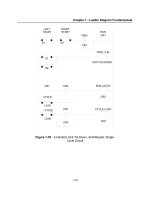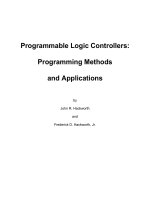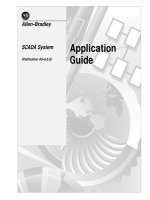04 RSLOGIX5000 software programming Training PLC Allen Bradley
Bạn đang xem bản rút gọn của tài liệu. Xem và tải ngay bản đầy đủ của tài liệu tại đây (2.4 MB, 48 trang )
DAY 1
SESSION 4
RSLOGIX 5000 SOFTWARE PROGRAMMING
6 – 10 December 2010
WHY RSLOGIX 5000 ?
Do you use Controllogix ?
It’s can configure with RSLOGIX 5000
6 – 10 December 2010
WHAT IS RSLOGIX 5000
•
Cross Reference
•
Status Bar
•
Forcing
•
Tag Browser
•
RSWho
•
Tag Editor
•
The Controller Organizer
•
Trending
•
Data Monitor
•
Data Scope
•
Data Type Editor
•
•
Ladder Editor
I/O Module Specification and
configuration
•
Function Block Editor
•
Logix 5000 Execution Model
•
Structured Text Editor
•
Program Properties
•
Sequential Function Chart
Editor
•
Routine Properties
•
Task Properties
•
Toolbar
•
Online Bar
6 – 10 December 2010
RSLOGIX 5000
• With RSLogix 5000 Enterprise Series software, user need only
one programming software for sequential, process, drive, and
motion control programming.
• IEC61134-3 compliant interface, symbolic programming with
structures and arrays, and an instruction set that serves many
types of applications.
6 – 10 December 2010
ENVIRONMENT RSLOGIX 5000
6 – 10 December 2010
ONLINE BAR
Status buttons
Status icons and menus
Status data
6 – 10 December 2010
FORCING
Forcing allows you to override an I/O module's values in the
controller. This value can be:
• A structure member of an I/O tag
I/O tag is a structured tag, the force is applied to its structure
members (of type BOOL, SINT, DINT, INT, or REAL). There is only
one restriction on which members can be forced (i.e., you cannot
force configuration data).
• An alias to an I/O structure member (of type BOOL, SINT, INT,
DINT, or REAL)
6 – 10 December 2010
RSWHO
RSWho is RSLinx’s network browser interface. RSWho allows you to
view all the active network connections from a single screen.
• The left pane of RSWho is the Tree Control, which shows networks and
devices. The right pane is the List Control, which shows all members
of a collection.
• The RSWho icon indicates a network. If the icon is animated, the
network is being browsed. Click on a network or device to start
browsing.
• When the Autobrowse checkbox is selected, RSWho continuously
browses the selected network.
6 – 10 December 2010
CONTROLLER ORGANIZER
The Controller Organizer is a graphical
representation of the contents of your
project. The default main folders in this tree
are:
• Controller Project Name - contains controller-scoped
tags, controller fault handler and the power up handler.
• Tasks - tasks are shown in this folder. Each task
shows its own programs with ladder routines, function
block routines, and program-scoped tags.
• Trends
• Data Types - shows predefined and user-defined data
types. User-defined data is created in this folder.
• I/O Configuration - contains the information about the
hardware configuration of this controller project.
6 – 10 December 2010
CROSS REFERENCE
• The Cross Reference function allows user to search entire
project and find every occurrence of the selected element
address.
• User can perform this function in either the online or offline
state.
• Cross Reference view can contain up to three separate tabs for
three different kinds of references.
• User can view cross reference information by:
• Logic
• Tag
• Tag hierarchy
6 – 10 December 2010
CROSS REFERENCE
6 – 10 December 2010
DATA MONITOR
The Data Monitor is the tab in the Program or Controller Tags
window from which you can:
• Read or write the values assigned to specific tags, both
online and offline.
• Set a tag description.
• Change a value’s display style.
• Change a force mask value.
6 – 10 December 2010
DATA TYPE EDITOR
The data type editor allows you to enter data types you define.
• Name, Indicates the new data type structure name (maximum 40
characters).
• Description, Provides a description of the new data type structure
(maximum 128 characters). This is a multi-line field with 3 lines
displayed at one time.
6 – 10 December 2010
DATA TYPE EDITOR
Data Type Member table
• The Data Type Member Table represents new data type
structure attributes. This table consists of the following
columns:
• Name, Enter the name of the member, up to a maximum of 40
characters.
• Data Type, Lists the data types for each member. You can also
specify dimension information.
• Style, Enter the display style format for the member:
• Binary, Decimal, Hexadecimal, Octal, Exponential, Float
6 – 10 December 2010
DATA TYPE EDITOR
6 – 10 December 2010
TAG EDITOR AND TAG BROSWER
The Tag Editor is the tab in the Controller Tags window or
Program Tags window :
• Create a new tag
• Delete an existing tag
• Modify tag parameters (e.g., name, alias for, produce a tag, display
style, data type and description)
6 – 10 December 2010
LADDER EDITOR
6 – 10 December 2010
FUNCTION BLOCK EDITOR
6 – 10 December 2010
SEQUENTIAL FUNCTION CHART
EDITOR
6 – 10 December 2010
STRUCTURED TEXT EDITOR
6 – 10 December 2010
GENERAL INSTRUCTION
• Bit (XIC, XIO, OTE, OTL, OTU, ONS, OSR, OSF, OSRI, OSFI)
• Input/output (TON, TOF, RTO, TONR, TOFR, RTOR, CTU, CTD, CTUD, RES)
• Compare (MSG, GSV, SSV)
• Compute/Math (CPT, ADD, SUB, MUL, DIV, MOD, SQR, SQRT, NEG, ABS)
• Move/Logical (MOV, MVM, BTD, MVMT, BTDT, CLR, SWPB, AND, OR, XOR,
NOT,
BAND, BOR, BX)
• Array (File)/Misc (FAL, FSC, COP, CPS, FLL, AVE, SRT, STD, SIZE)
• Array (File)/Shift (BSL, BSR, FFL, FFU, LFL, LFU)
• Sequencer (SQI, SQO, SQL)
6 – 10 December 2010
GENERAL INSTRUCTION (2)
• Program Control (JMP, LBL, JSR, RET, SBR, JXR, TND, MCR, UID, UIE, AFI, NOP,
EOT, SF...)
• For/Break (FOR, FOR...DO, BRK, EXIT, RET)
• Special (FBC, DDT, DTR, PID)
• Trigonometric (SIN, COS, TAN, ASN, ASIN, ACS, ACOS, ATN, ATAN)
• Advance Math (LN, LOG, XPY)
• Math Conversion (DEG, RAD, TOD, FRD, TRN, TRUNC)
• ASCII Serial Port (ABL, ACB, ACL, AHL, ARD, ARL, AWA, AWT)
• ASCII String (CONCAT, DELETE, FIND, INSERT, MID)
• ASCII Conversion (STOD, STOR, DTOS, RTOS, UPPER, LOWER)
6 – 10 December 2010
DATA SCOPE
When create tags, User specify them as either controller tags or
program tags.
• Controller tags apply to the entire controller, and can be used by
all programs. In other words, the data in a controller tag is
available to every task or program within the controller application.
• Program tags contain data that is used exclusively by the routines
within an individual program. This means that program tags can
have the same name in more than one program, allowing
programs to be copied and reused more easily.
6 – 10 December 2010
DATA SCOPE
Controller Tags
as Global Tags
Program Tags
as Local Tags
6 – 10 December 2010
I/O MODULE SPECIFICATION AND
CONFIGURATION
In a RSLogix 5000 project, all I/O modules must be manually
added to the project. There is no auto-configuration tool
available.
When user configure an I/O module, user specify characteristics
specific to this module. RSLogix 5000 automatically adds the
predefined tags for the module as controller scoped tags.
User can specify electronic keying to restrict a specific I/O
module to a specific slot within the chassis. Electronic keying
ensures that a module being inserted or configured is the proper
type
6 – 10 December 2010









